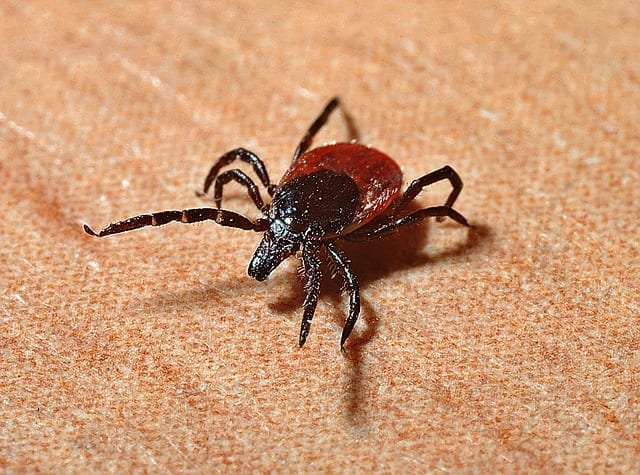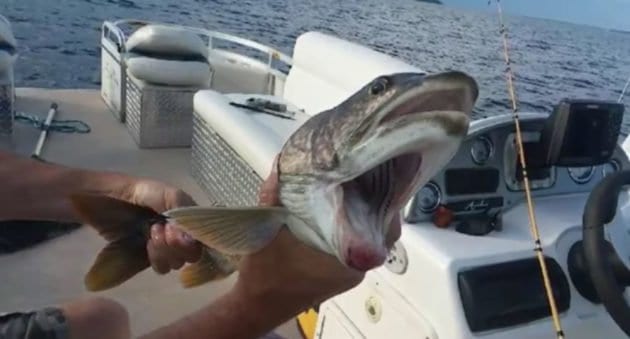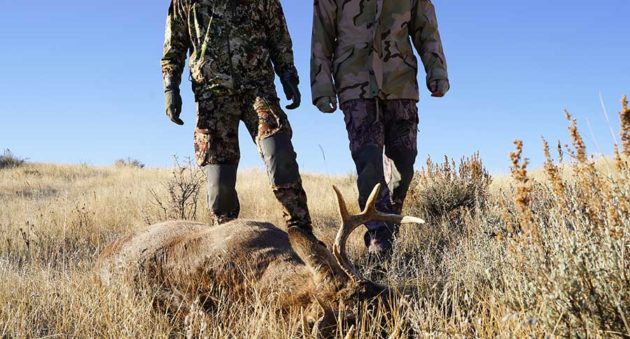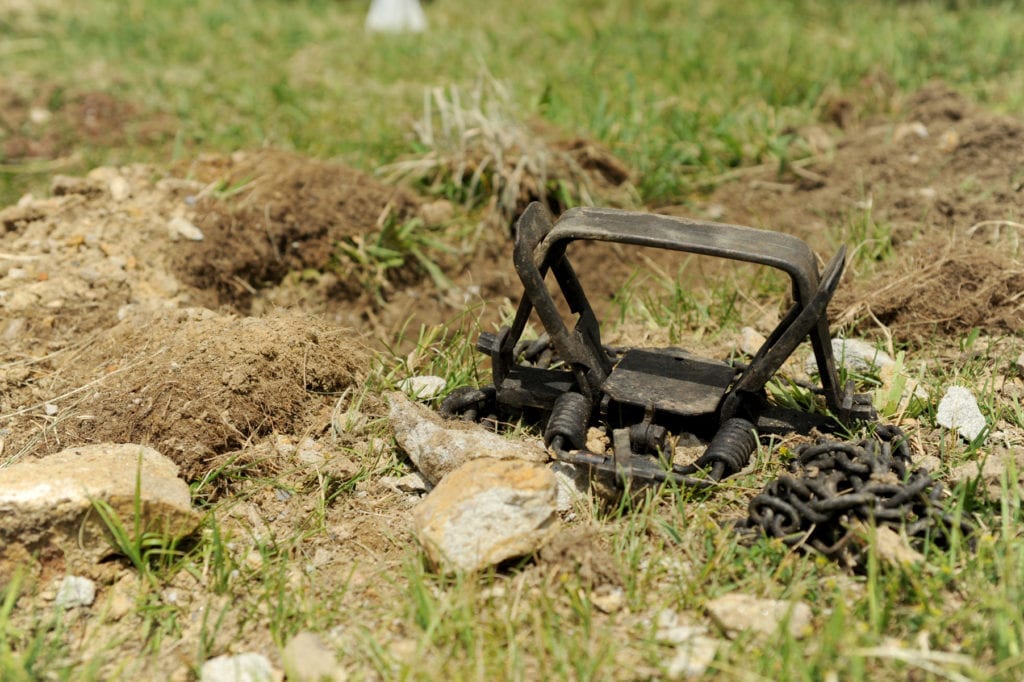Seeking adventure in the Arizona desert
By Tom Sternal
Mark Nissen and Randy Matis are different kinds of snowbirds. True, they spend most of every spring, summer and fall in Wisconsin before heading to southern Arizona from early December to early February. Also true (and they may argue this point), they are approaching the ages when this type of seasonal migration might be appealing to men of similar maturity. But this journey—and the ardent bird-guiding pair that makes it—is not the retiring kind. At the moment that most wingshooters settle in for the long off-season, Mark and Randy, partners in the Orvis-endorsed guiding service Classic Bird Hunts, set up shop for two months on the 28,000-acre Babacomari Ranch, in Elgin, Arizona. They are there for the same reason that I left the cozy confines of an Upstate New York winter: to chase a regal trio of wild quail.
Last fall, with the ruffed grouse season winding down but my bird-hunting itch not yet satisfied, I started thinking about what might be possible over the winter. I wanted something totally different but that did not require a passport or crawl through customs. I thought about Southern duck or goose hunting and even considered chasing woodcock in Louisiana, but I really wanted to stretch my legs. Some of the large quail plantations held appeal, but I was flying solo and wasn’t keen on socializing. I am also pretty fixed on wild birds, preferring to shoot a box of shells rather than a case. My online searching kept bringing me back to wild quail, and watching videos of erupting coveys of scaled (blue), Mearns and Gambel’s seemed just foreign enough to scratch that itch. I wanted a chance to score all three species so, with the Mearns’ limited range, this meant looking to the Southwest. That same online searching led me to Mark and Randy and the unique quail-hunting opportunities they offer.

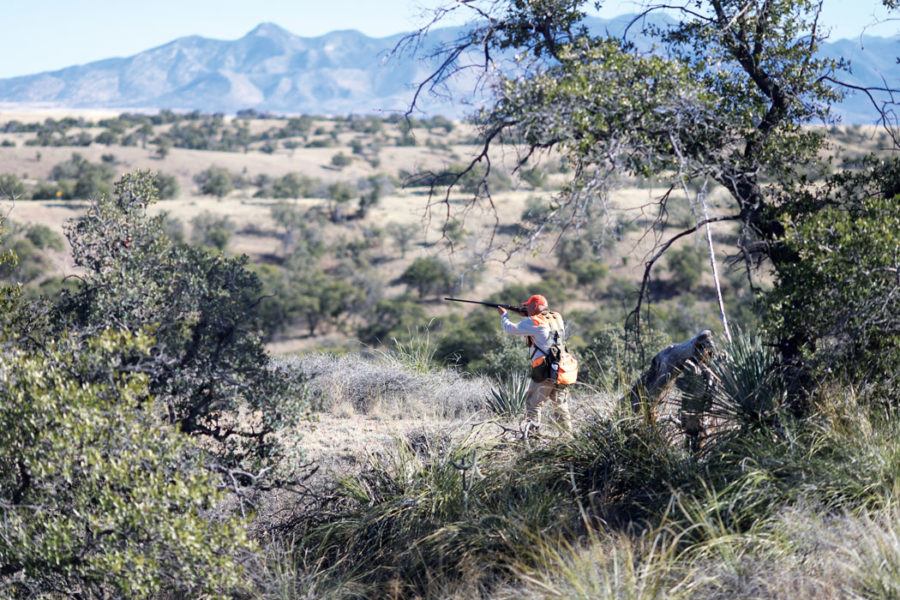
Arizona’s Babacomari Ranch, with its varied terrain and habitat, harbors a trio of wild quail: Gambel’s, Mearns and scaled. Left: Courtesy of Classic Bird Hunts; Right: Author’s photograph
The trip to Babacomari is, at the risk of hyperbole, dramatic. In my case, I boarded a 7 AM flight in Albany, New York, changed planes in Chicago, and landed in Tucson in time for a roadside lunch of authentic Mexican food. Forty-five minutes later I’d breezed through a border patrol station, and by mid-afternoon I was crossing cattle guards onto the ranch. (This might be a good time to talk about the border. The ranch is 30 miles from Mexico, or about 75 minutes by road. The presence of the border patrol is noticeable on the road, but the truth is that the impact—real and imagined—is minimal once you enter Babacomari.)
In a country where land is gobbled up and subdivided into smaller and smaller lots, it’s increasingly hard to fathom the size of Babacomari. I was told it stands as the nation’s 30th-largest privately held parcel. When it was bought in 1935 by Frank Cullen Brophy, most of the existential threats to owning land had subsided, but I was reminded more than once that previous owners had lost their scalps to raiding Apaches. By the time Brophy acquired the property, the greatest threat was a combination of droughts, monsoon floods and overgrazing. Bringing the land back to health was his unwavering commitment—halting all cattle grazing for 30 years, to allow the dry, rocky land stretching as far as you can see to regenerate. Prior to 1935 there were more than 12,000 head of cattle stressing the land and devastating wildlife. Today only 1,200 head of Herefords, Black Angus and Charolais are split between multiple lessees. That and other management decisions have allowed Babacomari to flourish—as much as one ranch can in the midst of what is commonly described as a nearly 30-year drought. Waterholes and rivers have largely dried up, save the monsoon rains that can drop a half-foot of water in a day. Get used to dust and dirt when quail hunting here (not to mention lots of getting out of and back into vehicles to open and close cattle gates). And, as I learned quickly, water is very important to quail.
Advertisement
googletag.cmd.push(function() { googletag.display(‘div-gpt-ad-1589809012571-0’); });
googletag.cmd.push(function() { googletag.display(‘div-gpt-ad-1589570644846-0’); });
This trip was less about being guided to the holy trinity of wild Southwestern quail and more about learning how to hunt them. Like I said, I’m a bit of a loner, so the quality of the hunting mattered far more than the trappings of a fancy lodge. When I’d spoken to Mark to set up the trip, I’d told him that I’d be coming alone and asked if my trip could be treated as a joint hunting trip–the guides and client hunting together. “We don’t really get to do much shooting,” he’d answered. “We’re booked up all season for quail, and even next fall [for grouse in Wisconsin] is looking pretty full. So if that’s what you want, sure!”
Since 2014 Classic Bird Hunts has had exclusive quail hunting rights to the ranch—something that took the outfit nearly 15 years to acquire. “Since 1999 we’d been hunting in and around the Patagonia region of Arizona and as far south as the Mexican border,” Mark said. “For years we’d crossed and surrounded the Babacomari, but we never had the opportunity to hunt it.” When Babacomari’s owners decided to renovate and rent a small late-19th Century adobe house on the ranch, Mark began a conversation that resulted in the exclusive use of the modest-but-comfortable three-bedroom house and the ranch through the quail season.
Any thoughts I had about warm-weather hunting 30 miles from the Mexican border quickly evaporated when Randy came in during the pre-dawn darkness to let me know it was 18 degrees outside. It was chilly as we climbed into his carefully organized and much-used Chevy truck with six eager Brittanys in back, but my blood had thickened in the Upstate New York winter.
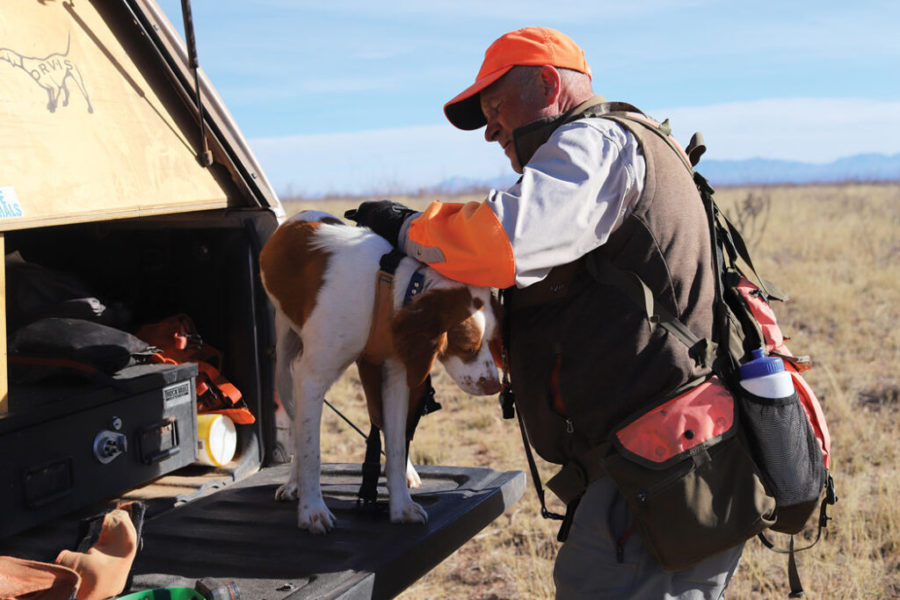
Within minutes we were crossing a rather elaborate steel bridge that, legend holds, was designed by Gustave Eiffel. While that fact certainly needs some checking, it adds to the mystique of a one-of-a-kind place. After crossing the bridge, Randy got out and demonstrated the art of quail calling. With different calls for different species, calls give hunters a leg up on locating elusive wild quail. I confess that, as a total novice quail hunter, I wasn’t sure if this was a gag. I was even more surprised when the call met with a response. “When we call quail,” Randy said, “we don’t hunt that covey for some time. We don’t even park in the same spot. These are not dumb birds. Quite the opposite. We mark the spot and come back later.”
As we continued on, I admit that I was glad Randy was driving. Due to a recent monsoon, some of the roads needed serious repair. Ruts up to 18 inches were not uncommon, and I could feel myself clenching as I’d stare down steep embankments with Randy’s 12-ply off-road tires inches from disaster.
Eventually we parked and, after a frank safety talk (beware of packs of javelinas, ornery cows with young calves, and ball-bearing-like rocks on descents), we headed afield—habitat consisting of patches of grass, yucca, cactus and low-lying mesquite. Randy was running a brace of Brittanys, and in less than 400 yards one dog was on point. A 12-bird covey of scalies flushed before we were within range, so we continued walking. We walked draws and over ridges, investigating areas where we thought the birds might have landed. And, indeed, they might have landed in those spots, but by the time we got there they had made tracks.
googletag.cmd.push(function() { googletag.display(‘div-gpt-ad-1589809274434-0’); });
googletag.cmd.push(function() { googletag.display(‘div-gpt-ad-1589571091070-0’); });
Eventually, after a mile-and-a-half arc that brought us back to the truck, we regrouped and, with fresh dogs, set off in a different direction. Within 10 minutes the Brittanys got birdy and snapped on point—holding for a bit before creeping forward. When three blue quail took flight, Randy swung to the left and fired. Although I could have sworn he missed, he commenced a search for a downed bird. I thought I had seen a bird land on the other side of a dry creek about 60 yards to my right, so I made a beeline in that direction, crossed the creek bed and, with my borrowed J.P. Sauer 16-gauge side-by-side in ready position, approached the spot. When the bird flushed and raced straight away from me, I was able to drop it with my first shot. In hand the scalie lived up to all the beautiful photos and descriptions that had nudged me to Arizona.
Randy congratulated me with modest praise, commenting on my trapshooting ability, and as we hunted our way back to the Chevy, my shooting percentage, once a sterling .1000, dropped to .333 as I missed a couple of birds that escaped across the windy Arizona plain.
By day’s end we’d gotten into a small covey of Mearns—the birds helped by a setting sun and steady tailwinds. This mix of quail, each favoring its own habitat but all tantalizingly available without lung-busting climbs, is the real draw of the unusually diverse habitat of the Babacomari. With Randy and Mark’s well-trained dogs and careful scouting, one rarely needs to walk more than 30 or 40 minutes before finding the next covey. Even though I was halfway through my hunt with two quail species still eluding me, I considered the day a huge success.
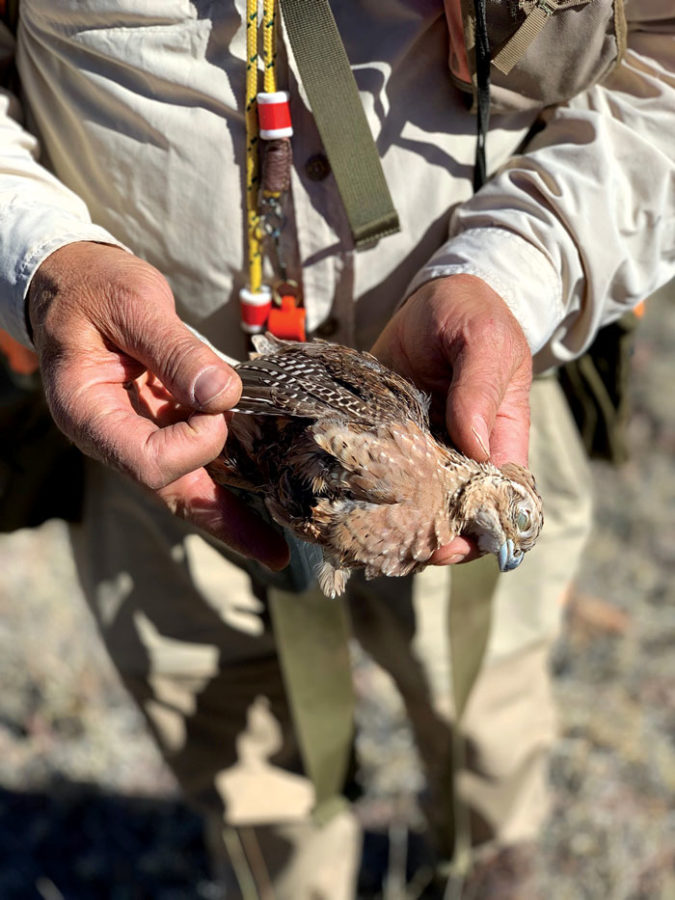
The next day—my last full day on the ranch—was far warmer than the previous, with the thermometer in Randy’s truck reading a balmy 23 degrees. This day we were going to hit spots known to hold Gambel’s and Mearns. I had come for an Arizona trifecta, and I was determined . . . if not also a bit annoyed with myself for not having carved out more time. By 8:30, I already had opened and closed several gates, leading Randy to ask, “How can you tell who in the truck is the cowboy? The one who doesn’t get out to open and close the gates.”
We parked near a riverbed that until recently had held water, and soon after Randy put orange boots on two of the Brittanys, the dogs began working an area of heavy brush with certain interest. Before I go any further, a note about the vegetation. Don’t think big saguaro cacti, rather think mean-looking brush—the kind that defends itself in all kinds of weather from all kinds of threats. Thorny, dry, offensive stuff. It’s also the kind of brush you don’t want to walk through. As off-putting as it is, it’s also pretty amazing. No matter the indignity or threat, the stuff survives, barely, year after year. And Randy’s dogs make the transition from the Wisconsin grouse woods to this barren, dry, rocky, prickly terrain remarkably well. Ultimately, it’s the habitat not the altitude that matters to the birds. Scalies often occupy grassy areas; Gamble’s roost in mesquites and lives oaks in draws and river bottoms; and Mearns—the big draw for many hunters—spread out in smaller family-based coveys around live oaks.
Within 10 minutes, the dogs were on point, but as we approached, a covey of 15 or so scalies took flight too low and too far for a shot. “I don’t think I’ve seen scalies in this area for a few years,” Randy said. It sounded like a good but slightly confounding omen. From there we began working the area above the riverbed, with the dogs racing tirelessly from spot to spot. We had walked no more than 200 yards from the first flush when the dogs went on point again. Here the vegetation was greener, taller and lusher, thanks to the water that was in the area. We made haste to get to the dogs, ready for anything. As we slowed to a creep, a dozen Gambel’s flushed in a 270-degree arc. Randy and I both missed twice, and as I was pulling the empties from the old extractor gun, more birds took off. I fumbled for shells, but by the time I was ready again the excitement appeared to have passed. I tried to hide my concern that this might have been my only chance to add to the diversity in my vest, but then one final bird flushed fast and away, making a dash for the riverbed. I dropped it no more than 20 yards from where we stood. As the dog brought back the lovely little quail, Randy said wryly, “Nice trap shot.”
googletag.cmd.push(function() { googletag.display(‘div-gpt-ad-1589809630577-0’); });
googletag.cmd.push(function() { googletag.display(‘div-gpt-ad-1589571496429-0’); });
We were back at the truck before 11 AM, having logged a couple of miles, and I now had two of the three species of quail bagged. That left us about five hours to find a Mearns.
For the final stretch, we drove through the main gate of the Babacomari and headed to another section of the ranch: a parcel of 5,000 fenced acres set among gentle hills and seemingly manicured by a responsible herd of cattle. This was to be our final stand, and Mark had been keeping track of several coveys of Mearns quail in the area and joined us for the hunt. This was my chance to see these two heralded guides—both having won the coveted Orvis Guide of the Year award—hunt together. And they put on a clinic: locating, tracking and flushing birds. Since the drought began in the early ’90s, the number and average size of coveys have shrunk. Currently, an average day might mean seven or eight coveys of different species. This day was better than average.
Up and over grassy hills we roamed, always following the dogs, and in the course of two hours we found five coveys of Mearns. Of course, finding quail and bringing them to bag are totally different things. Thankfully on this afternoon I did connect—on a Mearns that was crossing hard and fast out front—and I dropped it about 25 yards out. It was the kind of shot made for side-by-sides and upland hunters, swinging naturally across a landscape with nothing in between. It was also the kind of shot that erases the frustrations of all the other misses. As I admired the beautiful female and compared it to the handsome male Mark had bagged, I had nothing but respect for these delicate birds.
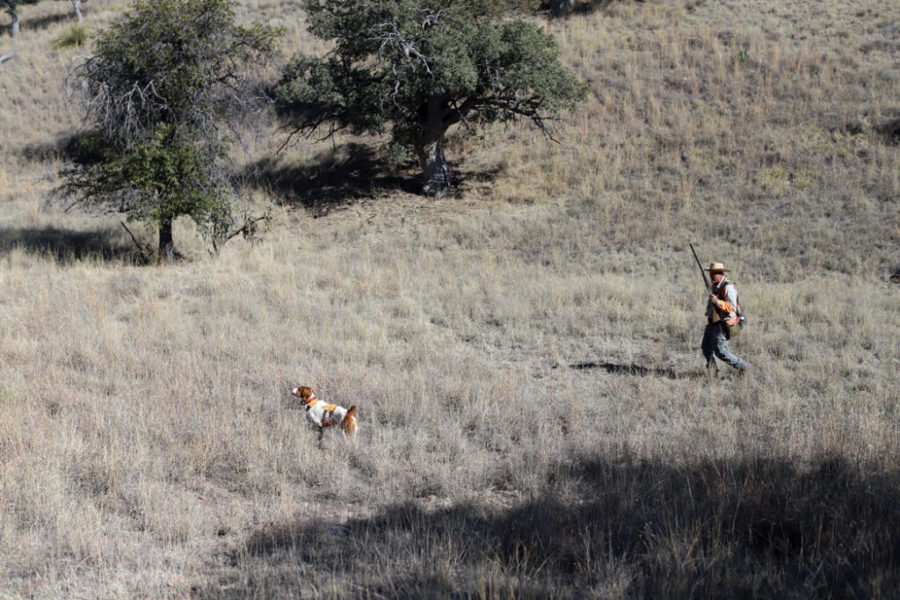
That evening I drove away from the ranch, past the hobby wineries and border patrol stations, winding up hills that became mountains, with the larger-than-life moon emerging over the vast horizon. I left satisfied, having accomplished what I hadn’t been sure I could. I had seen things that seemed almost surreal. I had met two guides who had helped me make sense of a world totally different from the one I was used to. And I remembered why I hunt: the early morning wakeups, the long trips, the uncomfortable newness of it all. It was to see and be something different, and then try to hold on to it as long as possible. For most of us, this is what constitutes an adventure; and I can’t wait for the next one. 
Note: Water is hugely important to quail, and winter rains are a key predictor. This past year saw the second consecutive winter of healthy precipitation, and for the upcoming season guides and experts are eyeing a banner year. For more information, visit classicbirdhunts.com.
The post Where the Wild Quail Are appeared first on Shooting Sportsman.
The views expressed by the editors, authors or users of this linked article are expressly theirs, and do not necessarily reflect the policies or opinions of Dallas Safari Club, its employees, members or assigns. Any concerns about a site user’s post should be addressed appropriately to that person. Any concerns about an advertiser, a user or any content on this site should be addressed to social@dscnortheast.org.


